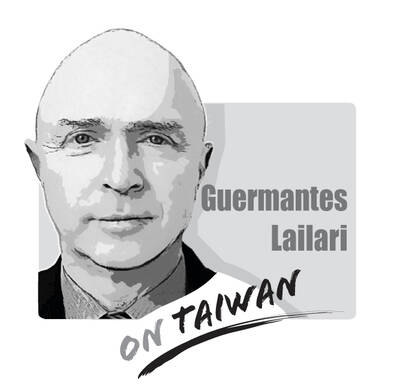Pegatron Corp CEO Tung Tzu-hsien (童子賢) has been expending a lot of energy pushing nuclear power as a way to reduce carbon emissions, as well as a “golden ratio” in which 30 percent of Taiwan’s energy would come from renewable sources, 30 percent from nuclear power and 40 percent from fire-powered plants.
This is a stark difference from the government’s zero carbon road map, which calls for an energy ratio of 60 to 70 percent renewables, 20 to 30 percent natural gas paired with carbon capture and 9 to 12 percent hydrogen-fired plants.
Tung pointed to the nuclear policies of Italy and Finland as examples to prop up his argument that nuclear and green energy can exist together.
However, the international situation for nuclear and renewable development trends is anything but that.
DEVELOPED NATIONS
First, only 30 countries use nuclear energy. Most countries do not.
The degree of economic development of many of these non-nuclear countries is on a par with or better than Taiwan’s.
Examples include Germany, Singapore and Israel.
In 2022, with energy prices skyrocketing in Europe following Russia’s invasion of Ukraine, Germany was forced to extend the service life of its last three nuclear power plants by several months.
Nevertheless, on April 15 last year, it still deactivated them.
Even with the German public demanding that the power plants continue to be used, the government said unequivocally that its non-nuclear power policy was here to stay.
CHINA
Second, most of the world’s nuclear reactors built in the past 20 years are in China, which had 55 nuclear power plants as of February last year.
Excluding China, there has been a global net decrease of 55 reactors.
However, even including China, the increase in renewable power facilities is still faster than that of nuclear plants.
TREND
Most importantly, at the 28th session of the Conference of the Parties to the UN Framework Convention on Climate Change in Dubai, United Arab Emirates, at the end of last year, despite a minority of countries advocating for using nuclear power to reduce carbon emissions, the consensus for carbon reduction activities was ultimately that the volume of renewable energy facilities around the globe before 2030 must be three times the current level, and the yearly efficiency rate for global renewable efficiency must be increased to twice the current level.
Thus, Taiwan must develop renewables and increase energy efficiency, and deactivate the No. 2 reactor of the Ma-anshan Nuclear Power Plant next to Pingtung County’s Ma-anshan (馬鞍山) on May 17 next year, as scheduled.
Doing so would allow Taiwan to advance and become a “nuclear-free homeland.”
Further developing nuclear power would run counter to ideals of global justice and threaten Taiwan’s sustainable development.
Development of renewables and economized resources is the way of the future.
Taiwan should work hard toward this goal. It must not let the advocacy for nuclear power restoration hinder the development of renewable energy sources, which would harm the nation’s fight against global warming and progress in transitioning to renewables.
Lin Ren-bin is an academic committee member of the Taiwan Environmental Protection Union.
Translated by Tim Smith
Chinese actor Alan Yu (于朦朧) died after allegedly falling from a building in Beijing on Sept. 11. The actor’s mysterious death was tightly censored on Chinese social media, with discussions and doubts about the incident quickly erased. Even Hong Kong artist Daniel Chan’s (陳曉東) post questioning the truth about the case was automatically deleted, sparking concern among overseas Chinese-speaking communities about the dark culture and severe censorship in China’s entertainment industry. Yu had been under house arrest for days, and forced to drink with the rich and powerful before he died, reports said. He lost his life in this vicious
A recent trio of opinion articles in this newspaper reflects the growing anxiety surrounding Washington’s reported request for Taiwan to shift up to 50 percent of its semiconductor production abroad — a process likely to take 10 years, even under the most serious and coordinated effort. Simon H. Tang (湯先鈍) issued a sharp warning (“US trade threatens silicon shield,” Oct. 4, page 8), calling the move a threat to Taiwan’s “silicon shield,” which he argues deters aggression by making Taiwan indispensable. On the same day, Hsiao Hsi-huei (蕭錫惠) (“Responding to US semiconductor policy shift,” Oct. 4, page 8) focused on
In South Korea, the medical cosmetic industry is fiercely competitive and prices are low, attracting beauty enthusiasts from Taiwan. However, basic medical risks are often overlooked. While sharing a meal with friends recently, I heard one mention that his daughter would be going to South Korea for a cosmetic skincare procedure. I felt a twinge of unease at the time, but seeing as it was just a casual conversation among friends, I simply reminded him to prioritize safety. I never thought that, not long after, I would actually encounter a patient in my clinic with a similar situation. She had

George Santayana wrote: “Those who cannot remember the past are condemned to repeat it.” This article will help readers avoid repeating mistakes by examining four examples from the civil war between the Chinese Communist Party (CCP) forces and the Republic of China (ROC) forces that involved two city sieges and two island invasions. The city sieges compared are Changchun (May to October 1948) and Beiping (November 1948 to January 1949, renamed Beijing after its capture), and attempts to invade Kinmen (October 1949) and Hainan (April 1950). Comparing and contrasting these examples, we can learn how Taiwan may prevent a war with